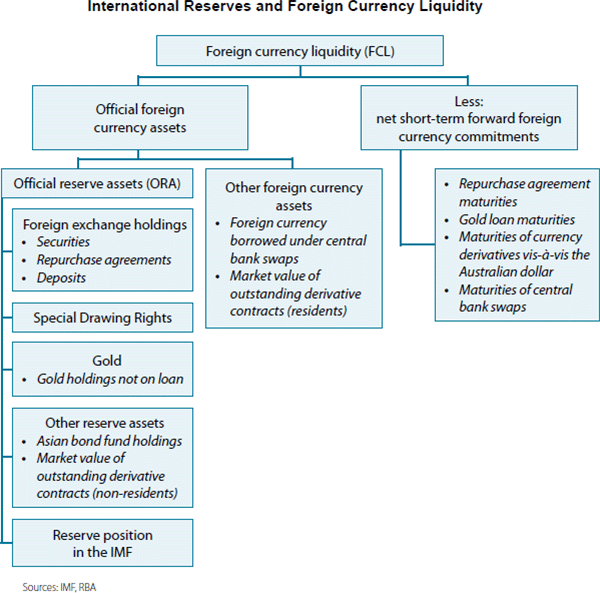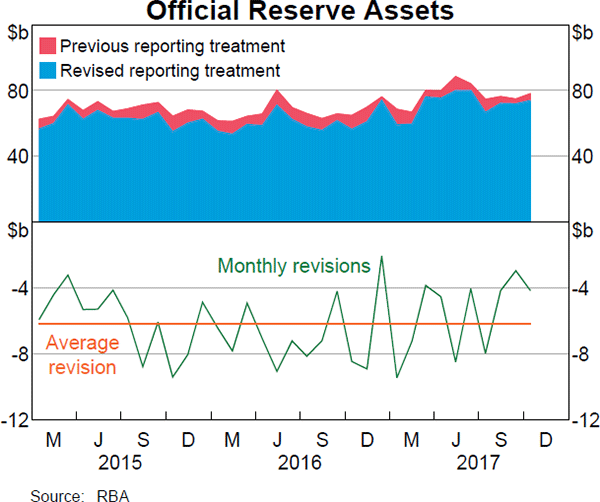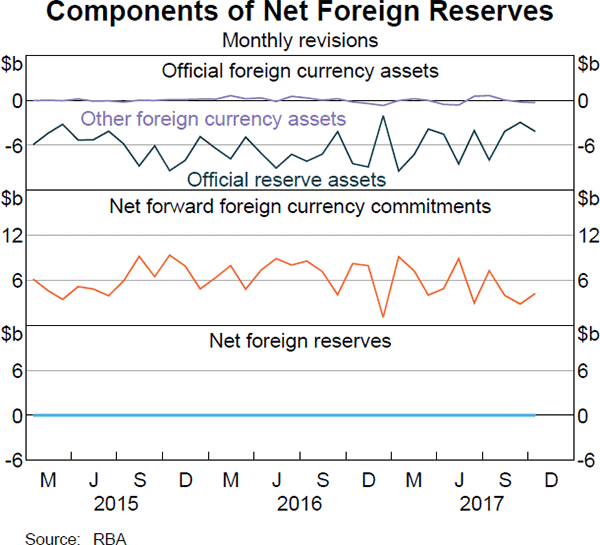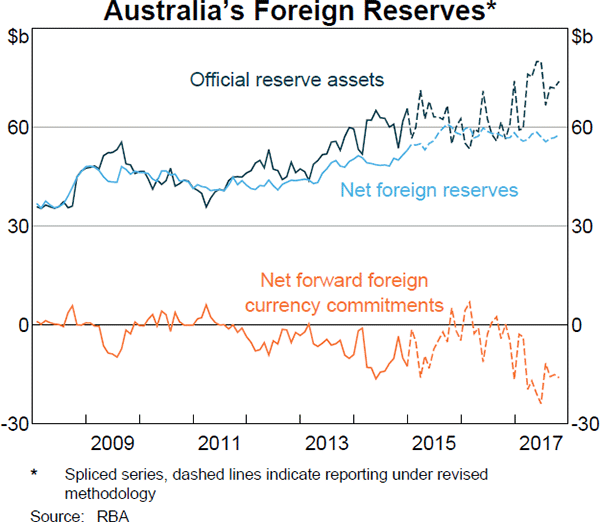Bulletin – December 2017 Australian Economy Reporting Australia's Foreign Reserve Holdings
- Download 1.29MB
Abstract
The Reserve Bank of Australia reports details of Australia's official reserve assets, foreign currency liquidity and net foreign reserves on a monthly basis. This article details changes that will make the Bank's reporting methodology consistent with current guidelines published by the International Monetary Fund (IMF). Data will be revised back to January 2015. While the new methodology implies a reduction in the reported gross level of Australia's official reserve assets, net foreign reserves will remain unchanged.
Introduction
Australia's official reserve assets (ORA) comprise foreign currency-denominated assets, gold bullion, Australia's reserve position in the IMF and Special Drawing Rights (SDRs), which is an international reserve asset created by the IMF. Aside from the reserve position in the IMF, which is owned by the Commonwealth Government of Australia, these assets reside on the balance sheet of the Reserve Bank of Australia. They are held to support the Bank's policy objectives.
The Bank regularly reports on the size and composition of Australia's ORA, as well as foreign currency liquidity (FCL) and net foreign reserves. For the most part, these data are currently prepared in accordance with guidelines published by the IMF.[1] However, over time, some differences have emerged between the Bank's reporting methodology and the IMF's guidelines (which are updated from time to time). This article identifies these differences and foreshadows changes that will bring the Bank's reporting methodology into line with the IMF's guidelines. These changes in methodology will alter the size of Australia's reported ORA, but will have no effect on Australia's net foreign reserves, which is a better measure of the capacity of the Bank to undertake foreign exchange (FX) policy operations.
The IMF's International Reserves and Foreign Currency Liquidity Framework
The IMF's International Reserves and Foreign Currency Liquidity (IRFCL) framework provides a means to account for the official foreign currency assets and net short-term forward foreign currency commitments of a country's authorities (Figure 1). Under this framework, FCL is defined as the difference between official foreign currency assets and net short-term forward foreign currency commitments. FCL represents the value of foreign currency that a country's authorities could deploy for policy purposes over the subsequent 12 months.
Official foreign currency assets comprise ORA, which are foreign currency claims on non-residents that meet certain criteria discussed below, as well as other foreign currency assets not considered ORA, such as certain foreign currency claims on domestic residents and foreign currency borrowed under bilateral central bank swap agreements. Net short-term forward foreign currency commitments comprise future inflows and outflows of foreign currency that will affect official foreign currency assets over the next 12 months. In the case of the Bank, these include the maturities of repurchase agreements (repos), gold loans and FX derivative contracts where one currency is the domestic currency (that is, the Australian dollar).

Net foreign reserves refers to the net foreign reserve asset position of Australia's authorities and is defined as official foreign currency assets less total net forward foreign currency commitments. FCL and net foreign reserves are identical when all outstanding net forward foreign currency commitments are contracted to mature within 12 months, which is typically the case for the Bank. Net foreign reserves is not separately identified in the IMF's IRFCL framework.
The Bank publishes Australia's IRFCL data on its website on a monthly basis. The composition of ORA is published separately via a press release each month. Official foreign currency assets, net forward foreign currency commitments and net foreign reserves are published in Statistical Table A4.[2]
Revised Approach to Reporting Official Reserve Assets
The IMF defines ORA as foreign currency claims on non-residents that are:
- Owned or under the effective control of the monetary authorities
- Readily available in the most unconditional form (that is, available with few constraints; for example, loans must be payable on demand)
- A liquid or marketable asset (can be bought or sold with minimum cost and time and for which there are ready and willing sellers and buyers within a few days)
- Denominated and settled in convertible foreign currencies that are freely usable for settlements of international transactions.[3]
Under the IMF's IRFCL framework, ORA must satisfy these basic principles and should be reported at the market value that represents the amount of foreign currency that could be raised upon liquidation in the market. Aligning the Bank's reporting methodology with the IMF's guidelines will change the reporting treatment of repos, reverse repos, derivative contracts and gold loans. The changes are outlined in Table 1.
These changes in methodology will be reflected in the IRFCL data published on the Bank's website for the month of December 2017 onwards. Data on ORA and net forward foreign currency commitments contained in Statistical Table A4 will be revised back to January 2015. At the same time, the format of Statistical Table A4 will be changed to provide disaggregation of official foreign currency assets between ORA and other foreign currency assets, and net forward foreign currency commitments will be defined more broadly.[4] Revisions will also be reflected in the ORA press release for December 2017.
Impact of reporting changes
Revisions to data from January 2015 to October 2017 will result in a decline in the value of reported ORA of around $6.1 billion or 9 per cent, on average (Graph 1).

The decline in ORA mainly reflects the effect of changes to the treatment of reverse repos, which contributed an average decline of around $5.8 billion to the drop in total ORA (Graph 2). As the Bank has had close to 10 per cent of its gold holdings on short-term loan over the past two years or so, the gold component of ORA will be revised lower by around $0.4 billion.
| Product | Previous treatment | Revised treatment |
|---|---|---|
| Reverse repurchase agreement | I. Include cash lent under repo in ORA | I. Exclude cash lent under repo from ORA |
| II. Exclude collateral held under repo from ORA | II. Exclude collateral held under repo from ORA | |
| III. Report cash lent under repo as an inflow in net short-term forward foreign currency commitments | ||
| Repurchase agreement | I. Include collateral lent under repo in ORA | I. Exclude collateral lent under repo from ORA |
| II. Exclude cash borrowed under repo from ORA | II. Include cash borrowed under repo in ORA | |
| III. Report collateral lent under repo and cash borrowed under repo, respectively, as an inflow and outflow in net short-term forward foreign currency commitments | ||
| Derivatives contracts | I. Include market values of (non-Australian dollar) interest rate and bond futures contracts in ORA | I. Include market values of (non-Australian dollar) interest rate and bond futures contracts and all FX derivative contracts with non-resident counterparties in ORA |
| II. Exclude market values of (non-Australian dollar) FX derivative contracts from ORA, but include them in other foreign currency assets | II. Include market values of (non-Australian dollar) interest rate and bond futures contracts and all FX derivative contracts with resident counterparties as other foreign currency assets | |
| III. Report notional values of FX derivative contracts vis-à-vis the Australian dollar maturing in the next 12 months as an inflow or outflow in net short-term forward foreign currency commitments | III. Report notional values of FX derivative contracts vis-à-vis the Australian dollar maturing in the next 12 months as an inflow or outflow in net short-term forward foreign currency commitments | |
| Gold loans | I. Include all gold holdings in ORA (including gold on loan) | I. Include gold holdings not on loan in ORA |
| II. Exclude any collateral held (or collateral pledged) under gold loans from ORA | II. Exclude gold on loan to all counterparties from ORA and other foreign currency assets | |
| III. Exclude any collateral held (or collateral pledged) under gold loans from ORA | ||
| IV. Report gold on loan as an inflow in net short-term forward foreign currency commitments | ||
|
Source: RBA |
||

The revisions to ORA will be accompanied by revisions to other foreign currency assets and net forward foreign currency commitments. These revisions, in aggregate, will have no effect on net foreign reserves (Graph 3). As noted earlier in this article, FCL will be equivalent to net foreign reserves as long as the Bank continues to have no net forward foreign currency commitments with more than 12 months to maturity.

Which Measure of Foreign Reserves?
This article has referred to three distinct measures of foreign reserves: ORA, net foreign reserves and FCL; for practical purposes, FCL can be considered equivalent to net foreign reserves. In recent years, Australia's ORA and net foreign reserves have diverged considerably. In October 2017, ORA exceeded net foreign reserves by $16 billion and, in June 2017, by as much as $23 billion (Graph 4). ORA have also tended to be considerably more volatile than net foreign reserves.

The difference between ORA and net foreign reserves primarily reflects net forward foreign currency commitments resulting from the Bank's domestic market operations. Over recent years, the Bank has increased its use of FX swaps when managing domestic liquidity (swapping Australian dollars for foreign currencies alters the supply of exchange settlement balances held by commercial banks at the Bank in the same way as a repo transaction).[5] Under these transactions, the Bank has mostly been a net lender of Australian dollars and a borrower of foreign currency, typically for short terms of no longer than three months. Foreign currency borrowed in this way temporarily increases both the Bank's official foreign currency assets (and ORA) and net forward foreign currency commitments until the maturity of the FX swap, when the foreign currency is returned. These transactions have contributed to most of the volatility in ORA in recent years.
Temporary increases in ORA arising from short-term borrowings are not considered as an increase in the policy capacity of foreign reserves due to the short rollover period of the Bank's FX swap book. If the Bank did deploy these borrowings for the purpose of FX market intervention amid a depreciation in the Australian dollar, it could prove very costly to repay or roll over maturing FX swaps if the exchange rate continued to depreciate in the short term. Some central banks do acquire foreign reserves for policy purposes through long-term borrowings, which defer the rollover of foreign currency-denominated liabilities for time frames of, for example, five years. However, this strategy still exposes a central bank to rollover risk if foreign reserves are run down and any depreciation in the domestic currency is sustained.[6]
Net foreign reserves constitutes the value of official foreign currency assets not subject to this type of rollover risk and can be considered the effective capacity of Australia's authorities to undertake FX policy operations. The majority of net foreign reserves are foreign exchange holdings, which, in practice, would be the component deployed by the Bank to effect FX market intervention (Graph 5). The Bank last conducted FX market intervention in November 2008.

Summary
A change to the Bank's methodology for compiling data as part of the IMF's International Reserves and Foreign Currency Liquidity framework has resulted in downward revisions to the gross level of official reserve assets for January 2015 to October 2017. Corresponding revisions to other foreign currency assets and net forward foreign currency commitments have, however, resulted in no change in net foreign reserves, which represents the effective capacity of Australia's authorities to undertake foreign exchange policy operations.
Footnotes
The author is from the Risk and Compliance Department. [*]
Gold and foreign exchange assets reported on the Bank's balance sheet are prepared in accordance with Australian accounting standards and may therefore differ from the basis used to report ORA, FCL and net foreign reserves. [1]
See International Reserves and Foreign Currency Liquidity, Official Reserve Assets and Statistical Table A4 – Foreign Exchange Transactions and Holdings of Official Reserve Assets. [2]
For more information on the IMF's definition of ORA, see IMF (2009) and IMF (2013). [3]
In addition to notional values of unsettled spot and forward FX transactions where one currency is the Australian dollar, net forward foreign currency commitments will include future maturities of the Bank's gold loans, repos, reverse repos and transactions under the Bank's bilateral currency swap agreements with other central banks. [4]
For further details, see RBA (2017). [5]
For further details, see Vallence (2012). [6]
References
IMF (International Monetary Fund) (2009), Balance of Payments and International Investment Position Manual, 6th Edition, IMF, Washington, DC, pp 111–118.
IMF (2013), International Reserves and Foreign Currency Liquidity: Guidelines for a Data Template, 2nd Edition, IMF, Washington, DC.
RBA (Reserve Bank of Australia) (2017), ‘Operations in Financial Markets’, Reserve Bank of Australia Annual Report 2017, pp 47–57.
Vallence C (2012), ‘Foreign Exchange Reserves and the Reserve Bank's Balance Sheet’, RBA Bulletin, December, pp 57–64.